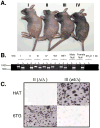Personalized chemotherapy profiling using cancer cell lines from selectable mice
- PMID: 23340293
- PMCID: PMC3612923
- DOI: 10.1158/1078-0432.CCR-12-2127
Personalized chemotherapy profiling using cancer cell lines from selectable mice
Abstract
Purpose: High-throughput chemosensitivity testing of low-passage cancer cell lines can be used to prioritize agents for personalized chemotherapy. However, generating cell lines from primary cancers is difficult because contaminating stromal cells overgrow the malignant cells.
Experimental design: We produced a series of hypoxanthine phosphoribosyl transferase (hprt)-null immunodeficient mice. During growth of human cancers in these mice, hprt-null murine stromal cells replace their human counterparts.
Results: Pancreatic and ovarian cancers explanted from these mice were grown in selection media to produce pure human cancer cell lines. We screened one cell line with a 3,131-drug panel and identified 77 U.S. Food and Drug Administration (FDA)-approved drugs with activity, and two novel drugs to which the cell line was uniquely sensitive. Xenografts of this carcinoma were selectively responsive to both drugs.
Conclusion: Chemotherapy can be personalized using patient-specific cell lines derived in biochemically selectable mice.
©2012 AACR.
Conflict of interest statement
Figures



Similar articles
-
Galectin-3 Mediates Tumor Cell-Stroma Interactions by Activating Pancreatic Stellate Cells to Produce Cytokines via Integrin Signaling.Gastroenterology. 2018 Apr;154(5):1524-1537.e6. doi: 10.1053/j.gastro.2017.12.014. Epub 2017 Dec 21. Gastroenterology. 2018. PMID: 29274868
-
Histone deacetylase inhibition is synthetically lethal with arginine deprivation in pancreatic cancers with low argininosuccinate synthetase 1 expression.Theranostics. 2020 Jan 1;10(2):829-840. doi: 10.7150/thno.40195. eCollection 2020. Theranostics. 2020. PMID: 31903153 Free PMC article.
-
Delta like ligand 4 induces impaired chemo-drug delivery and enhanced chemoresistance in pancreatic cancer.Cancer Lett. 2013 Mar 1;330(1):11-21. doi: 10.1016/j.canlet.2012.11.015. Epub 2012 Nov 27. Cancer Lett. 2013. PMID: 23200678
-
Use of nano engineered approaches to overcome the stromal barrier in pancreatic cancer.Adv Drug Deliv Rev. 2018 May;130:50-57. doi: 10.1016/j.addr.2018.06.014. Epub 2018 Jun 26. Adv Drug Deliv Rev. 2018. PMID: 29958925 Free PMC article. Review.
-
Stromal biology and therapy in pancreatic cancer: a changing paradigm.Gut. 2015 Sep;64(9):1476-84. doi: 10.1136/gutjnl-2015-309304. Epub 2015 May 20. Gut. 2015. PMID: 25994217 Review.
Cited by
-
Detection and cellular imaging of human cancer enzyme using a turn-on, wavelength-shiftable, self-immolative profluorophore.J Am Chem Soc. 2014 May 28;136(21):7575-8. doi: 10.1021/ja5030707. Epub 2014 May 14. J Am Chem Soc. 2014. PMID: 24813575 Free PMC article.
-
Biological and molecular effects of small molecule kinase inhibitors on low-passage human colorectal cancer cell lines.Biomed Res Int. 2014;2014:568693. doi: 10.1155/2014/568693. Epub 2014 Sep 17. Biomed Res Int. 2014. PMID: 25309914 Free PMC article.
-
Patient-derived xenograft models: an emerging platform for translational cancer research.Cancer Discov. 2014 Sep;4(9):998-1013. doi: 10.1158/2159-8290.CD-14-0001. Epub 2014 Jul 15. Cancer Discov. 2014. PMID: 25185190 Free PMC article. Review.
-
Establishment and molecular characterisation of seven novel soft-tissue sarcoma cell lines.Br J Cancer. 2016 Oct 25;115(9):1058-1068. doi: 10.1038/bjc.2016.259. Epub 2016 Aug 25. Br J Cancer. 2016. PMID: 27560552 Free PMC article.
-
Unearthing new genomic markers of drug response by improved measurement of discriminative power.BMC Med Genomics. 2018 Feb 6;11(1):10. doi: 10.1186/s12920-018-0336-z. BMC Med Genomics. 2018. PMID: 29409485 Free PMC article.
References
-
- Wright JC, Cobb JP, Gumport SL, Golomb FM, Safadi D. Investigation of the relation between clinical and tissue-culture response to chemotherapeutic agents on human cancer. N Engl J Med. 1957;257:1207–11. - PubMed
-
- Schrag D, Garewal HS, Burstein HJ, Samson DJ, Von Hoff DD, Somerfield MR. American Society of Clinical Oncology Technology Assessment: chemotherapy sensitivity and resistance assays. J Clin Oncol. 2004;22:3631–8. - PubMed
-
- Samson DJ, Seidenfeld J, Ziegler K, Aronson N. Chemotherapy sensitivity and resistance assays: a systematic review. J Clin Oncol. 2004;22:3618–30. - PubMed
-
- Dangles-Marie V, Pocard M, Richon S, Weiswald LB, Assayag F, Saulnier P, et al. Establishment of human colon cancer cell lines from fresh tumors versus xenografts: comparison of success rate and cell line features. Cancer Res. 2007;67:398–407. - PubMed
-
- Gazdar AF, Kurvari V, Virmani A, Gollahon L, Sakaguchi M, Westerfield M, et al. Characterization of paired tumor and non-tumor cell lines established from patients with breast cancer. Int J Cancer. 1998;78:766–74. - PubMed
Publication types
MeSH terms
Substances
Grants and funding
LinkOut - more resources
Full Text Sources
Other Literature Sources
Medical
Molecular Biology Databases
Miscellaneous

